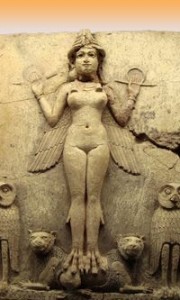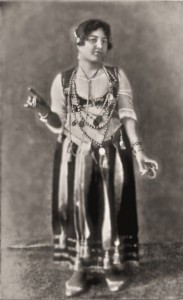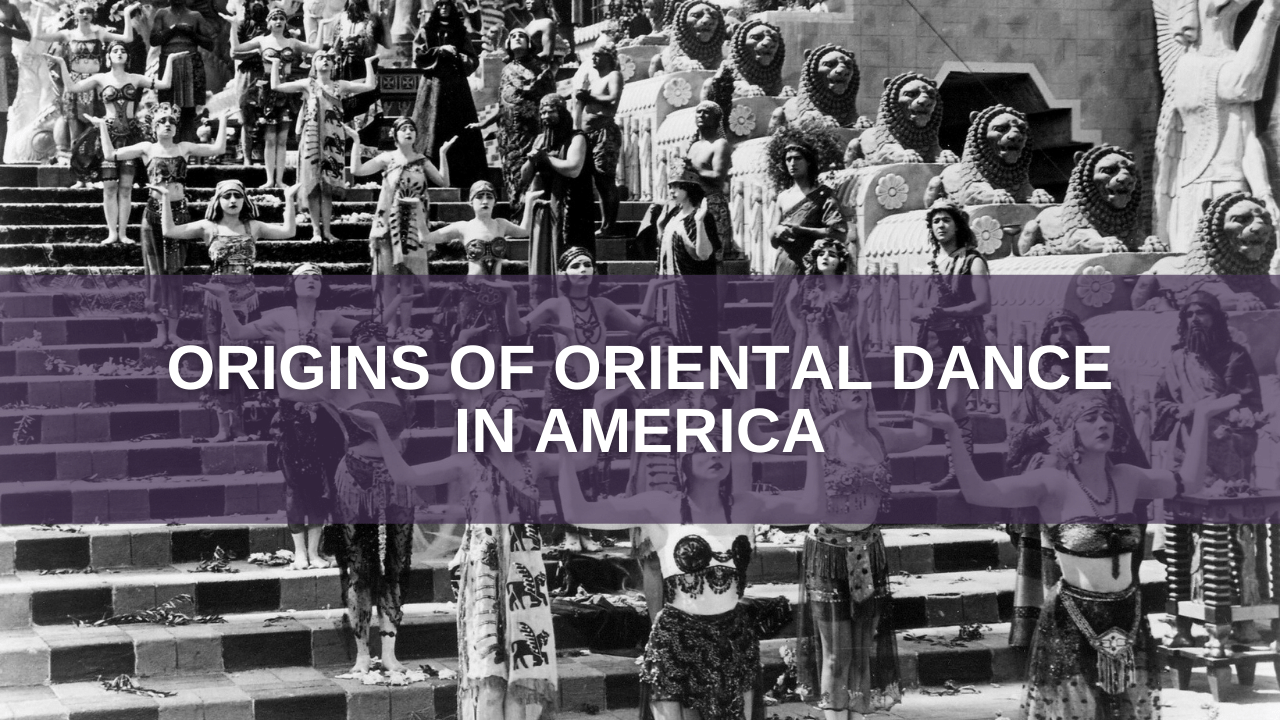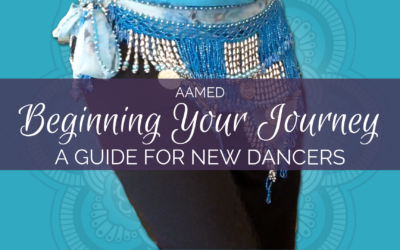Oriental dance aka “belly dance” or “Raqs Sharqi” in Arabic, is considered one of the oldest dance forms on Earth, but no one knows for sure where it came from. Over the last few decades, archaeological, societal, and cultural discoveries, regarding the Middle East, dance historians have more information resources concerning the dance’s origins more than ever before.
 Currently, there are two “historical” schools of thought about where the dance may have originated. The first proposes that the dance may have started in religious dance rituals and practices of primitive cultures in the Middle East or as far east as modern-day India, particularly Goddess worship. We know that most cultures of the past had practiced traditional dances, religious and otherwise, in just about every aspect of their life. However, no evidence exists today that suggests belly dance was specifically related to any religious practice.
Currently, there are two “historical” schools of thought about where the dance may have originated. The first proposes that the dance may have started in religious dance rituals and practices of primitive cultures in the Middle East or as far east as modern-day India, particularly Goddess worship. We know that most cultures of the past had practiced traditional dances, religious and otherwise, in just about every aspect of their life. However, no evidence exists today that suggests belly dance was specifically related to any religious practice.
The second school of thought suggests that belly dance could have acted as birth preparation and birthing aid practice. It is said, the other women of the household would demonstrate to the pregnant woman how to move her stomach to relieve labor pain and hasten the arrival of her baby. Many say this practice, maybe the origin of common belly dance abdominal movements, such as the undulation and tummy flutter. This birthing ritual is still practiced in many parts of Northern Africa and the Middle East today.
Myths about Belly Dance
 There are also many myths about belly dance based on inaccurate Western views of the Middle East and its cultures. Many of these myths stem from the Orientalists of the 18th and 19th centuries when Europeans and other Westerners began to travel to the Near East and North Africa. Perplexed and fascinated by what they saw and heard in the Middle East, artists and writers began to create works often depicting sensational fantasy and eroticism. Oriental art of this period frequently features scenes of near-nude odalisques, dancing women, Turkish baths, and harems. These “fantasy” depictions, like TV and magazines of today, were powerful influences on Western thinking regarding the Middle East and Islamic culture.
There are also many myths about belly dance based on inaccurate Western views of the Middle East and its cultures. Many of these myths stem from the Orientalists of the 18th and 19th centuries when Europeans and other Westerners began to travel to the Near East and North Africa. Perplexed and fascinated by what they saw and heard in the Middle East, artists and writers began to create works often depicting sensational fantasy and eroticism. Oriental art of this period frequently features scenes of near-nude odalisques, dancing women, Turkish baths, and harems. These “fantasy” depictions, like TV and magazines of today, were powerful influences on Western thinking regarding the Middle East and Islamic culture.
As a result, the West has been greatly influenced by these images – even today. One common myth originating from Orientalism proposes that women in harems would vie for the affection of the Sultan by dancing for him or that harem women would lie around all day half-naked dreaming up ways to please their man while hand-feeding him grapes. Sadly, these types of myths have perpetuated much misinformation about what belly dance actually is. For centuries, the harem (root word means “forbidden”) was simply the section of the home where all the women (and usually children) of the household reside and do their normal daily activities.
Another myth claims that belly dance is for women only or that men should not or do not belly dance, but in the Middle East, belly dance is a basic part of their dance movement vocabulary and is a part of everyday life for everyone: women, men, and children. Belly dance to the typical Egyptian is the equivalent of how the typical American may dance in a club or at a party. This is just the way they dance – the way ALL people dance there, at parties, clubs, weddings, gatherings, etc. Over there, elements of the dance are done by the average person, all genders, and all age groups, though men typically have a different carriage and way of moving when they belly dance compared to the more feminine way women would execute the moves. Of course, the oriental dance performed by common folk is very different from the highly stylized and refined version(s) that “belly dance performers” do all over the world, but the basic movements are still apparent.
Do note, however, that belly dance performance is considered a woman’s performance art in the Middle East. Men are less encouraged, to choose belly dance as an occupation, though it’s acceptable to dance in certain celebratory situations. Folk dancing, like Saidi or Nubian, styles are considered more acceptable forms of occupation for male dancers, than belly dance. But there are male dancers who have made themselves big Oriental dance stars, despite social pressures.
Belly Dance Comes to America
 It is believed the first major appearance of belly dance in America happened at the World’s Columbian Exposition aka the Chicago World’s Fair in 1893. The fair featured a re-creation of an Egyptian market aptly named “Streets of Cairo” where vendors sold Egyptian goods, and dance and music groups from countries like Egypt, Morocco, Syria, Tunisian, Algeria, Turkey, among others, shared their cultural tradition on the stages along the “midway”. The dancer’s hip and stomach movements were considered vulgar and strange compared to the popular waltz and ballet which were acceptable forms of dance of the time. The nearly, fully covered dancers were also considered very controversial for not being corseted, which was the fashion trend and “respectable” custom of the day.
It is believed the first major appearance of belly dance in America happened at the World’s Columbian Exposition aka the Chicago World’s Fair in 1893. The fair featured a re-creation of an Egyptian market aptly named “Streets of Cairo” where vendors sold Egyptian goods, and dance and music groups from countries like Egypt, Morocco, Syria, Tunisian, Algeria, Turkey, among others, shared their cultural tradition on the stages along the “midway”. The dancer’s hip and stomach movements were considered vulgar and strange compared to the popular waltz and ballet which were acceptable forms of dance of the time. The nearly, fully covered dancers were also considered very controversial for not being corseted, which was the fashion trend and “respectable” custom of the day.
 An entertainment promoter for the Exposition named Sol Bloom (pictured right) quickly took advantage of the controversy surrounding the foreign dancers and began billing the dance as the “hootchee-kootchee” dance in order to get more customers. This advertising tactic was a huge success. Soon, others including Vaudeville promoters labeled its all-American adult entertainment as “hootchee-kootchee” dance in their popular shows, which later became known as burlesque, the precursor to modern-day stripping or “exotic” dance. Though burlesque dancers used some of the movements they saw the foreign dancers do, it was not in part or in whole the same traditional and folkloric dance as performed by the “real” belly dancers at the World’s Fair. This misuse of the term belly dance subsequently spurred two of the most common misconceptions about belly dance – that belly dance is related to the striptease or “exotic dance” and that belly dance is about seduction. Over 100 years later, the belly dance community at large is still trying, unsuccessfully, to educate people about the true dance form and bring to light its inaccurate association with stripping and burlesque.
An entertainment promoter for the Exposition named Sol Bloom (pictured right) quickly took advantage of the controversy surrounding the foreign dancers and began billing the dance as the “hootchee-kootchee” dance in order to get more customers. This advertising tactic was a huge success. Soon, others including Vaudeville promoters labeled its all-American adult entertainment as “hootchee-kootchee” dance in their popular shows, which later became known as burlesque, the precursor to modern-day stripping or “exotic” dance. Though burlesque dancers used some of the movements they saw the foreign dancers do, it was not in part or in whole the same traditional and folkloric dance as performed by the “real” belly dancers at the World’s Fair. This misuse of the term belly dance subsequently spurred two of the most common misconceptions about belly dance – that belly dance is related to the striptease or “exotic dance” and that belly dance is about seduction. Over 100 years later, the belly dance community at large is still trying, unsuccessfully, to educate people about the true dance form and bring to light its inaccurate association with stripping and burlesque.
Sol Bloom is also said to have coined the term “belly dance,” which is a translation of the French term “Danse du ventre” or dance of the stomach, said to have been first used by French invaders to Egypt in the late 18th century. The term belly dance, only made the foreign dancing more scandalous to Victorian mannered Americans, that considered direct terminology for body parts like “belly” unwholesome talk.
 At the Exposition, a Syrian-born dancer named Farida Mazar-Spyropoulos (pictured left) performed with “The Algerian Dancers of Morocco” under the name “ Fatima”. Farida later claimed to have been the first “Little Egypt”, but did not perform under this title at the Exposition. Since then many dancers, Middle Eastern and otherwise, have used the name “Little Egypt” to promote themselves, some more respectable than others.
At the Exposition, a Syrian-born dancer named Farida Mazar-Spyropoulos (pictured left) performed with “The Algerian Dancers of Morocco” under the name “ Fatima”. Farida later claimed to have been the first “Little Egypt”, but did not perform under this title at the Exposition. Since then many dancers, Middle Eastern and otherwise, have used the name “Little Egypt” to promote themselves, some more respectable than others.
One such dancer, and probably the most recognized as “Little Egypt,” was actually a Vaudeville burlesque dancer named Ashea Wabe (pictured below right). Her most infamous claim to fame was being questioned at a New York City bachelor party on December 19, 1896, for Clinton Barnum Seeley (grandson of circus moggle P.T. Barnum) after police were tipped off “that indecent dances were going to be given by Little Egypt and others. The incident made national headlines, gaining Little Egypt instant notoriety; she quickly rose in popularity as an entertainer and was rumored to have earned $500 a performance. [That was a lot of money back then.] Some years later, she parodied the incident that made her famous, on Broadway.
 Some inaccurate sources mistake Farida Mazar-Spyropoulos and Ashea Wabe as the same
Some inaccurate sources mistake Farida Mazar-Spyropoulos and Ashea Wabe as the same
dancer, claiming that Wabe’s “Little Egypt” performed at the Exposition, but this is not factual. Farida was the star dancer at the Exposition. No known source indicates Ashea Wabe was even a performer at the Exposition.
The popularity of belly dance at the Columbian Exposition spread like wildfire around the country. With some of the Middle Eastern dancers touring with Barnum and Bailey’s Circus and Thomas Edison featuring dancers in his new moving pictures, it did not take long for America to catch on with this dancing craze. Europe had already been introduced to belly dance at the World’s Fair in Paris in 1889 spurring Oscar Wilde’s controversial play “Salome”, which opened in Paris in 1896. In 1905, Richard Strauss premiered his famous one-act opera ‘Salome” based on Wilde’s play. As early as 1916, American cinema began depicting dancing temple maidens and Egyptian queens to satisfy the American public’s appetite for all things exotic. Most representations of Middle Eastern dance in these early films are simply classical dance forms embellished with pseudo-Oriental poses and movement.
Egyptian Golden Era of Belly Dance
 Back in Egypt, a Lebanese-born entertainer named Badia Masabni (pictured left) began opening entertainment clubs in Cairo, Egypt circa 1926. Badia’s “sala(s)” featured a variety of acts like singing, music, comedy, and eventually dancing, and were suspected to be the first venues to feature fully orchestrated Arabic music. A singer and dancer herself, Badia taught many of the dancers working in her club. Badia is said to have first introduced western dance forms, stage dynamics, and the use of choreography into Egyptian dance’s Baladi style, which was, for the most part, un-Westernized up to that point. This “new” stage-friendly version of Egyptian dance has now become the basis for belly dance style over the last century. Many claim that Badia may have been influenced by American cinema’s portrayal of Oriental-style costuming and was the first to use the two-piece tummy revealing costumes in her shows, likely an attempt to appeal to tourists expecting to see on stage what they see in films.
Back in Egypt, a Lebanese-born entertainer named Badia Masabni (pictured left) began opening entertainment clubs in Cairo, Egypt circa 1926. Badia’s “sala(s)” featured a variety of acts like singing, music, comedy, and eventually dancing, and were suspected to be the first venues to feature fully orchestrated Arabic music. A singer and dancer herself, Badia taught many of the dancers working in her club. Badia is said to have first introduced western dance forms, stage dynamics, and the use of choreography into Egyptian dance’s Baladi style, which was, for the most part, un-Westernized up to that point. This “new” stage-friendly version of Egyptian dance has now become the basis for belly dance style over the last century. Many claim that Badia may have been influenced by American cinema’s portrayal of Oriental-style costuming and was the first to use the two-piece tummy revealing costumes in her shows, likely an attempt to appeal to tourists expecting to see on stage what they see in films.
In the 1920s, Egypt began producing its own films and typically featured actresses that pulled double duty as dancers. By the 1940s and 1950s, many dancers who began dancing in Badia’s clubs were now cinema stars with dance empires of their own. Dancers like Samia Gamal, Tahiya Carioca, Naima Akef, and Hagar Hamdy still epitomize belly dance today.
Visit our page Belly Dancers of Egypt’s Golden Era to watch these influential belly dancers.
Jewels in the Navel
Meanwhile back in the USA, American cinema introduced the Hays Code censorship standards, which required actresses using stomach exposing costumes to cover up their navel. Actresses performing belly dancer-like roles began wearing jewels in their navel to circumvent the Hays code’s decency rules. Many mistook this costuming item as an authentic Middle Eastern custom. Soon after, Middle Eastern dancers began wearing them to further cater to the expectations of their tourist audience. However, navel jewelry was never a custom in the Middle East and their use has ceased “over there”. The general public and many new dancers still expect the navel jewel to be a part of the traditional belly dance costume, but dancers today consider their use passé and a beginner’s mistake.
Post-Golden Era
 During the 1960s-1980s, we saw more wonderful dancers from Egyptian cinema crossing over into television. One such notable was actress, singer, dancer Fifi Abdo (pictured left), who is considered by many to be the ideal Baladi Egyptian dancer. Nagwa Fouad, Mona El Said, Soheir Zaki, Nadia Gamal, and many others also became huge stars.
During the 1960s-1980s, we saw more wonderful dancers from Egyptian cinema crossing over into television. One such notable was actress, singer, dancer Fifi Abdo (pictured left), who is considered by many to be the ideal Baladi Egyptian dancer. Nagwa Fouad, Mona El Said, Soheir Zaki, Nadia Gamal, and many others also became huge stars.
Since the Columbian Exposition of 1893, Greek and Middle Eastern immigrants have made America their new home. Once arriving, many newcomers sought to experience their dance, cuisine, and music here in ethnic communities in large cities around the country. Those communities often had restaurants and nightclubs featuring belly dancing. Early on, dancers from Middle Eastern countries like Turkey, Lebanon, Syria, and Egypt would be the likely performers, but non-Middle Eastern dancers began showing interest and soon learned the moves just by watching the native dancers or via very informal apprenticeships. Today, it is very rare to see a Middle Eastern dance performer in nightclubs and restaurants in America, as well as in Egypt. This is, in part, due to the assimilation of Arabs/Turks here in the US and due to the rise of conservative Islamic fundamentalism in Muslim communities, once considered moderate, in Egypt and around the world.
America experienced another national-wide resurgence of belly dance interest in the mid-20th century with the release of many records like the landmark Turkish album “How to Make Your Husband a Sultan.”
Belly Dance Today
Belly Dance has seen another revival in recent years due to popular belly dance exercise instructional videos by dancers like Veena and Neena and from hip-shaking pop stars like Shakira and Beyonce. Today, belly dance takes many forms from the more traditional, yet contemporary Egyptian and Turkish styles to newer offshoots like American Tribal. There are also numerous fusion styles that blend classic dance forms like ballet, across the dance spectrum to fantasy styles that meld theatrical themes with belly dance. It has also become a popular way to get and stay fit.
Along with the rise in fusion styles, the global knowledge boom has made it possible for dancers to be more informed and educated about belly dance and the many related traditional and folkloric dance forms more than ever before. Knowledge seekers are able to find cultural dance information much more easily. Dancers are privileged to choose from a myriad of constantly flowing educational sources like workshops, DVDs, books, and the Internet. We also enjoy the greater availability of belly dance music and an abundance of dance instructors, which was unheard of twenty years ago.
Sadly, misinformed and/or dubious dancers are still perpetuating old incorrect myths, Orientalists stereotypes, and unfortunate associations in belly dance’s past to capitalize on the age-old advertising adage of “sex sells”. A great majority of belly dancers and the belly dance community at large strive to promote the dance as a viable, respected dance form while trying to avoid any connection with the “harem fantasy” or “dancing for your sultan” attitudes of the past. Hopefully, someday, belly dance will be respected for the dance art form that it is, instead of what people want to believe it is.
Resources
*There were also American-born dancers performing re-creations of what they thought was an accurate representation of dances from Middle Eastern countries.
http://query.nytimes.com/gst/abstract.html?res=9800E0DD143FE433A25753C3A9649D946197D6CF
http://query.nytimes.com/mem/archive-free/pdf?res=980DE4DD1430E132A25755C2A9639C94689ED7CF
Baladi – adjective, also spelled beledi, balady, baledy, means “of the country” or “of the people”, also used to describe a rhythm, a dance style, and a type of music.
Share Origins of Oriental Dance in America - Belly Dance History
-
Anna
Beginning Your Journey
Lifetime accessBeginner12 lessons0 quizzes159 studentsStarting any new adventure can be intimidating. Wouldn't you like someone with lots of experience…Free






